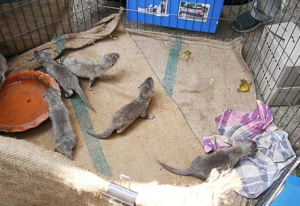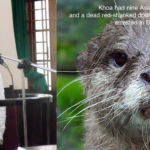
A new TRAFFIC report has found 6,000 otters seized in Asia over the past 35 years and warns that the figure is only a fraction of the actual little-documented illegal trade.
The vast majority of the 167 enforcement cases from 15 Asian countries studied involved seizures of otter skins in China and India.
The new study – Illegal Otter Trade: An Analysis of Seizures in Selected Asian Countries (1980 – 2015) – also finds an increase in seizures of live otters destined for the pet market, marking a potentially rising threat to otter species in Asia.
Although numbers are small, in Southeast Asian countries the quantities of live otters seized increased in the last five years (2011-2015) to average six individuals per seizure compared to three to four previously. A maximum of 16 live otters were seized in 2013.

“Very little effort has been made in the past to tackle the illegal trade in otters here in Southeast Asia, largely due to ignorance of the situation and an overall lack of concern for ‘low-profile species’,” said Dr Chris R. Shepherd, Regional Director of TRAFFIC in Southeast Asia.
“It is high time this group of species receive the conservation attention they so urgently deserve.”
The authors also reported that illegal trade records involving otters were scarce and that the trade was likely to be much larger than official seizure data alone suggested.
This, together with a lack of population information, legal loopholes that enable trafficking and the low priority given to otter trade, forms a large gap in information on the impacts of illegal trade on the region’s wild otter populations.
“What little we know is already setting off alarm bells. Further investigations, including into new trends like otter trade online, are critical if we are to understand the scope of the threats facing otters and take the necessary steps to protect them,” said Nicole Duplaix, Chair of the IUCN-SSC Otter Specialist Group.
The study, which focused on four Asian otter species – Small-clawed Otter (Aonyx cinereus), Smooth-coated Otter (Lutrogale perspicillata), Hairy-nosed Otter (Lutra sumatrana) and the Eurasian otter (Lutra lutra) – was launched during the 13th International Otter Congress in Singapore.
The congress brought together specialist from across Asia to share their work on otters in the region with the illegal trade in Asian otters a key topic of discussion.




